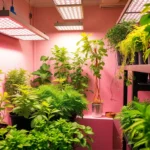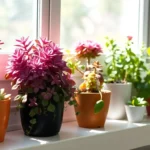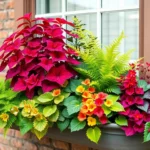We’ve all been there – standing in the plant section of our local nursery feeling completely overwhelmed by the endless green options. You want to bring some life into your home but you’re terrified of becoming another plant parent with a black thumb. The good news? Starting your indoor plant journey doesn’t have to be intimidating or expensive.
Indoor plants aren’t just Instagram-worthy decor – they’re natural air purifiers that boost our mood and create a calming atmosphere in any space. The secret to success lies in choosing the right plants that can forgive our beginner mistakes while still looking absolutely stunning.
We’ve curated a list of the most resilient and beautiful indoor plants that’ll thrive even if you forget to water them occasionally. These green companions are perfect for busy lifestyles and will give you the confidence to expand your plant collection over time.
Snake Plant: The Nearly Indestructible Choice
Snake plants earn their reputation as the ultimate beginner friendly houseplant through their remarkable resilience and forgiving nature. We’ve selected this stunning succulent as our top recommendation because it thrives even when you forget about it for weeks.
Low Light and Drought Tolerance
Adaptability defines the snake plant’s most impressive characteristic, as it flourishes in various lighting conditions from bright indirect light to low light corners. We’ve observed these plants surviving in windowless offices and dimly lit bathrooms where other plants would quickly decline. Watering requirements remain minimal since snake plants store water in their thick, fleshy leaves and prefer to dry out completely between waterings.
Neglect actually benefits snake plants more than constant attention, making them perfect for busy schedules or frequent travelers. We recommend watering only every 2-3 weeks during growing season and monthly during winter months. Overwatering poses the greatest threat to snake plants, so err on the side of caution and wait until the soil feels completely dry before adding water.
Air Purifying Benefits
NASA’s Clean Air Study identified snake plants as exceptional air purifiers that remove formaldehyde, xylene, toluene, and nitrogen oxides from indoor environments. We appreciate how these plants work around the clock to improve our home’s air quality while requiring minimal care. Oxygen production continues even at night unlike most plants, making snake plants ideal bedroom companions that won’t compete for oxygen while you sleep.
Research demonstrates that snake plants can remove up to 87% of harmful toxins within 24 hours of placement in a room. We find this particularly valuable for modern homes filled with synthetic materials, cleaning products, and electronics that release various chemicals into our living spaces.
Simple Propagation Methods
Division offers the easiest propagation method by separating the plant’s natural offshoots or “pups” that grow from the main root system. We simply remove the entire plant from its pot, gently separate the connected sections, and replant each division in fresh potting soil. Success rates reach nearly 100% with this method since each division already has established roots.
Leaf cuttings provide another straightforward propagation technique where we cut healthy leaves into 3-4 inch sections and plant them in moist soil. Patience becomes essential as new plants develop slowly over 2-3 months, but this method allows you to create multiple plants from a single leaf. Water propagation works well too by placing leaf cuttings in a glass of water until roots develop before transferring to soil.
Pothos: The Trailing Beauty That Thrives Anywhere
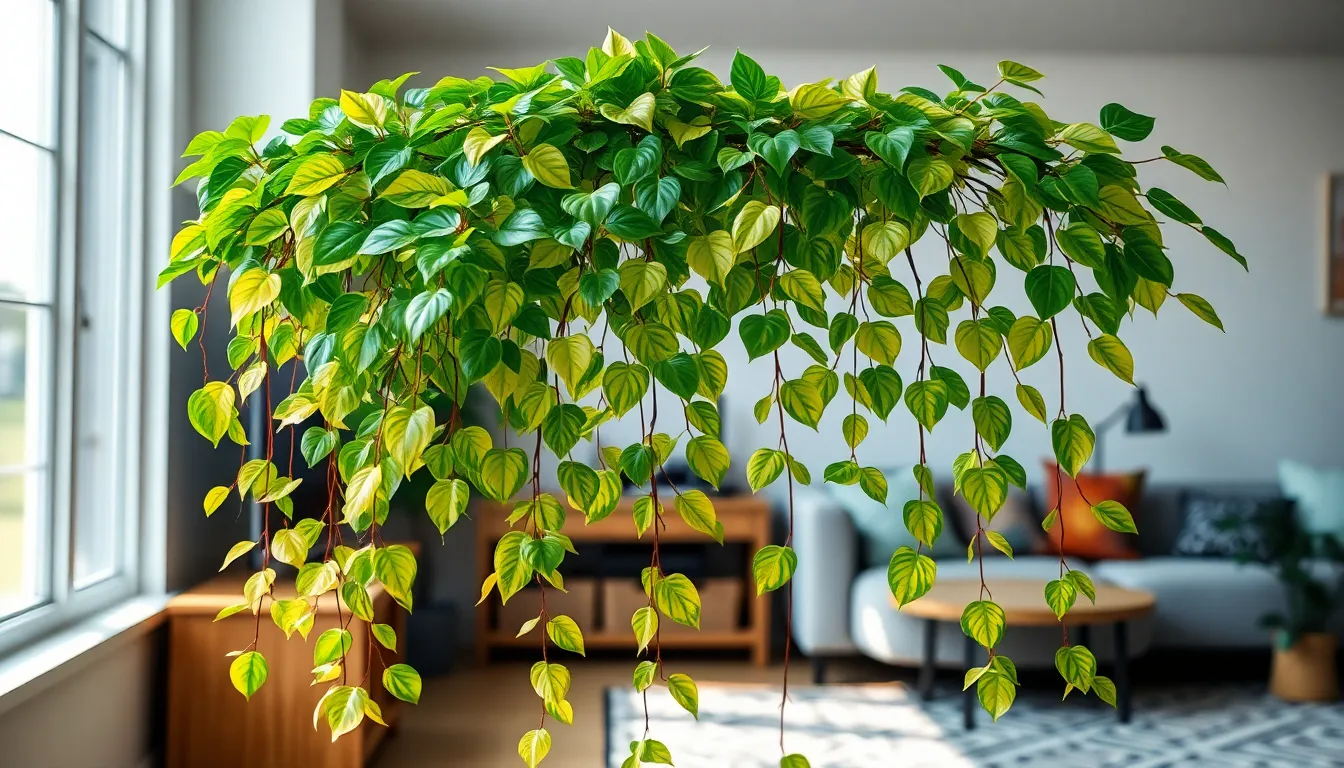
Meet the plant that’s earned its reputation as the most forgiving houseplant for beginners everywhere. Pothos (Epipremnum aureum) combines stunning visual appeal with virtually foolproof care requirements.
Versatile Growing Conditions
Pothos adapts to almost any lighting situation you can provide indoors. This remarkable flexibility means you can place it in low indirect light corners where other plants would struggle, or brighten up spaces with moderate bright light exposure. We love how this adaptability makes pothos perfect for apartments, offices, or homes with varying light conditions throughout different rooms.
Lighting requirements change seasonally, but pothos maintains its lush appearance regardless. You’ll find this plant thriving in bathrooms with minimal natural light or flourishing near windows with abundant indirect sunlight. Temperature fluctuations rarely bother pothos, making it ideal for beginners who worry about creating perfect growing environments.
Easy Water or Soil Propagation
Propagating pothos requires nothing more than scissors and a glass of water. Simply cut a vine section with at least one node, place it in water, and watch roots develop within weeks. We recommend this water propagation method because it’s virtually impossible to fail.
Soil propagation works equally well for those who prefer direct planting. Take your cutting and place it directly into potting soil, keeping it slightly moist until roots establish. Both methods multiply your plant collection effortlessly, letting you share cuttings with friends or expand your own indoor garden.
Root development happens quickly with pothos cuttings, often showing visible growth within 7-10 days in water. Transfer water-rooted cuttings to soil once roots reach 2-3 inches long for best results.
Variegated Varieties for Visual Interest
Golden Pothos features stunning yellow and green variegation that brightens any space instantly. This classic variety maintains its colorful patterns even in lower light conditions, though brighter light enhances the golden hues significantly.
Marble Queen Pothos offers elegant white and green variegation that creates a sophisticated look in modern interiors. We find this variety particularly striking when allowed to trail from hanging baskets or climb moss poles.
Different pothos varieties include Neon Pothos with its bright chartreuse leaves, Jade Pothos with solid green foliage, and Pearls and Jade with subtle cream variegation. Each variety maintains the same easy care requirements while providing unique aesthetic appeal for your indoor plant collection.
Spider Plant: The Self-Propagating Wonder
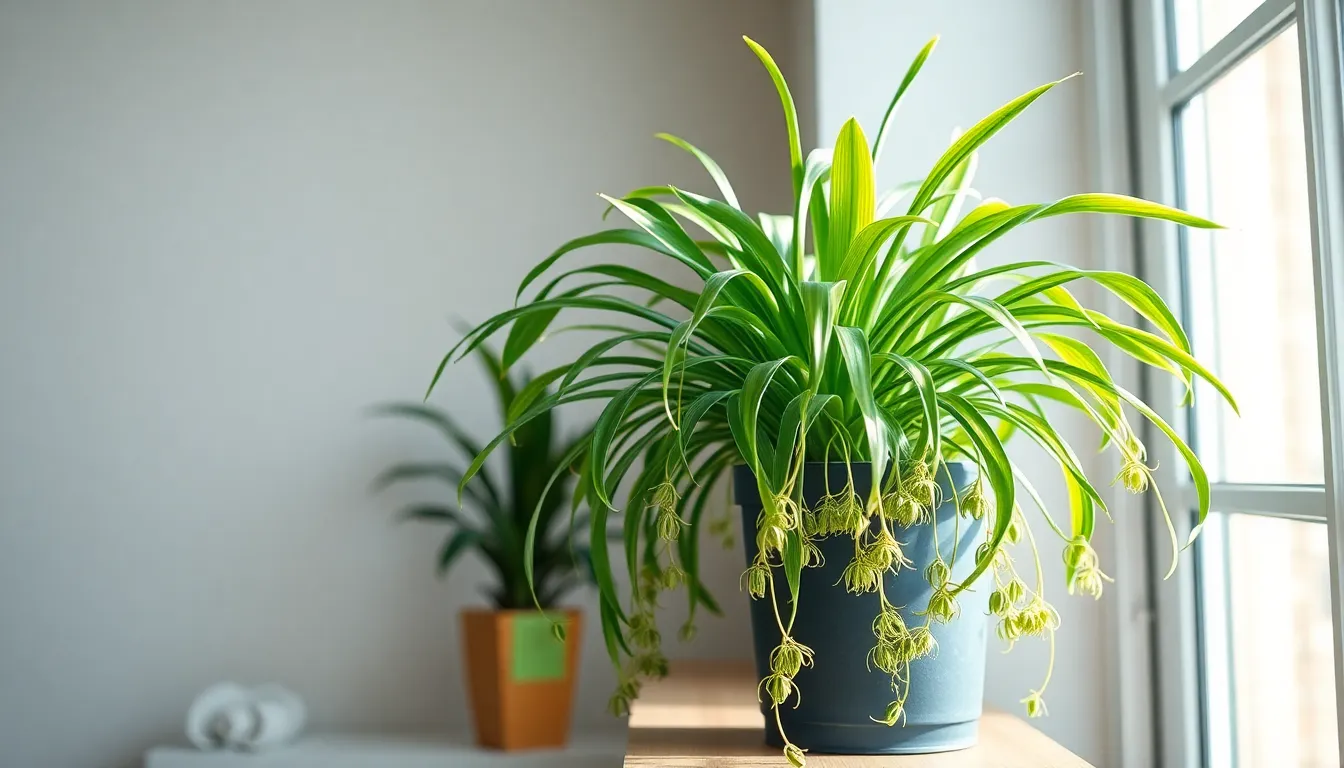
The spider plant (Chlorophytum comosum) stands out as one of our top beginner recommendations due to its remarkable ability to produce offspring naturally. This fascinating houseplant creates its own propagation system that’ll have you sharing plants with friends and family in no time.
Baby Plantlet Production
Spider plants naturally develop small plantlets that dangle from long stems extending from the mother plant. These baby spider plants, often called “spiderettes,” form complete root systems while still attached to their parent. We can easily root these plantlets in water or directly in soil without any special tools or techniques.
Each mature spider plant can produce dozens of baby plantlets throughout the growing season. The plantlets appear as miniature versions of the parent plant and develop their own root systems within weeks. Once rooted, we can snip the connecting stem and transplant the babies into their own pots, creating an endless supply of new plants.
Adaptable Light Requirements
Spider plants thrive in bright indirect light but demonstrate remarkable tolerance for various lighting conditions. They’ll grow successfully in low to moderate light environments, making them perfect for offices or rooms with limited natural light. Direct sunlight can scorch their leaves, so we recommend placing them near windows with filtered light or in well lit areas away from harsh sun exposure.
The plant’s ability to adapt to different light levels means we don’t need to worry about finding the perfect spot in our homes. Spider plants continue growing and producing plantlets even in less than ideal lighting conditions, though they’ll develop more vibrant foliage and faster growth in brighter spaces.
Pet-Safe Option for Animal Lovers
Spider plants offer peace of mind for pet owners since they’re non-toxic to both cats and dogs. Unlike many popular houseplants that can be harmful if ingested, spider plants pose no danger to curious pets who might take a nibble. This safety feature makes them an excellent choice for households with furry family members.
Many cats find spider plants particularly attractive, often batting at the dangling plantlets or chewing on the long leaves. While this behavior won’t harm our pets, it might damage the plant’s appearance, so we recommend placing spider plants in elevated locations if our cats show too much interest.
ZZ Plant: The Glossy Low-Maintenance Marvel
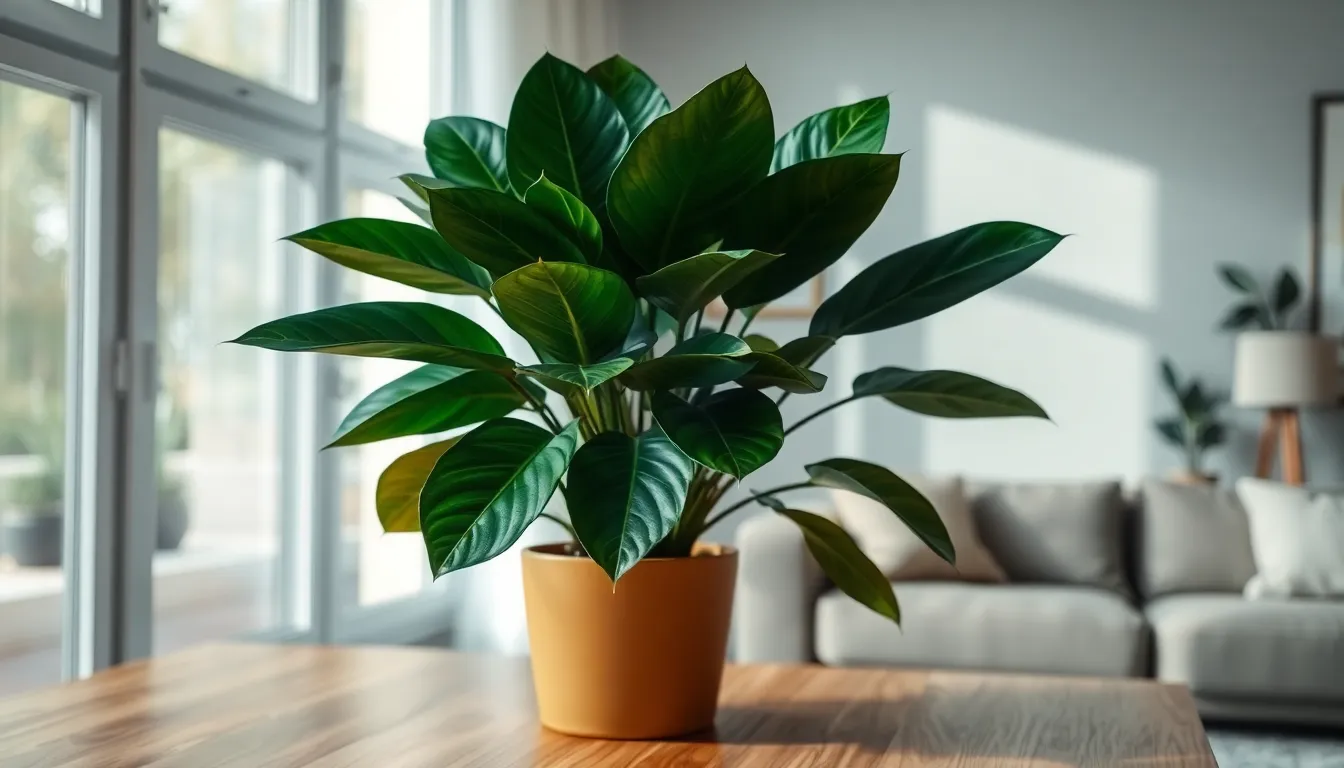
We’ve discovered that the ZZ Plant (Zamioculcas zamiifolia) stands out as one of the most beginner-friendly indoor plants available. Its combination of stunning aesthetics and minimal care requirements makes it perfect for those just starting their plant journey.
Extreme Drought Tolerance
Drought tolerance reaches extraordinary levels with the ZZ Plant, making it virtually indestructible for forgetful plant parents. You can leave this resilient beauty without water for weeks, and it’ll continue thriving thanks to its ability to store moisture in its thick stems and roots. Busy schedules and occasional neglect won’t phase this plant since it actually prefers periods of dryness between waterings.
Watering frequency becomes incredibly simple with ZZ Plants compared to other houseplants. We recommend watering only when the soil feels completely dry, which typically occurs every 2-3 weeks depending on your home’s humidity and temperature. Overwatering poses more risk than underwatering, so it’s better to err on the side of caution.
Survival mechanisms built into the ZZ Plant include specialized water storage capabilities that allow it to endure extended dry periods. These adaptations make it ideal for beginners who worry about maintaining consistent watering schedules or those who travel frequently.
Shiny Foliage Appeal
Glossy leaves create an immediate visual impact that elevates any indoor space with their mirror-like surface. The waxy, dark green foliage reflects light beautifully, creating natural highlights that make rooms appear brighter and more vibrant. Each leaf maintains its lustrous appearance year-round without requiring any special polishing or maintenance.
Aesthetic versatility allows ZZ Plants to complement both modern and traditional decor styles effortlessly. We’ve seen them enhance minimalist spaces with their clean lines and architectural form, while also adding sophisticated greenery to more eclectic interiors. Their upright growth pattern creates an elegant silhouette that works well as a floor plant or desktop accent.
Light reflection properties of the ZZ Plant’s foliage help maximize existing light in your space. This natural light-improving quality makes rooms feel more open and airy, particularly beneficial in apartments or offices with limited natural light sources.
Slow Growth Advantage
Maintenance requirements stay minimal with ZZ Plants due to their naturally slow growth rate, making them perfect for beginners who prefer low-commitment plants. You won’t need to worry about frequent repotting, pruning, or size management since these plants typically grow only a few inches per year. This leisurely growth pace means your ZZ Plant can remain in the same pot for 2-3 years without becoming rootbound.
Space management becomes effortless since ZZ Plants won’t quickly outgrow their designated spots in your home. We appreciate how this predictable growth pattern allows for better long-term planning when arranging your indoor garden or designing your living space around your plants.
Cost effectiveness improves with ZZ Plants because their slow growth means fewer expenses for larger pots, fresh soil, and plant food over time. This economic advantage makes them particularly appealing for budget-conscious beginners who want beautiful plants without ongoing maintenance costs.
Rubber Tree: The Statement Plant for Beginners
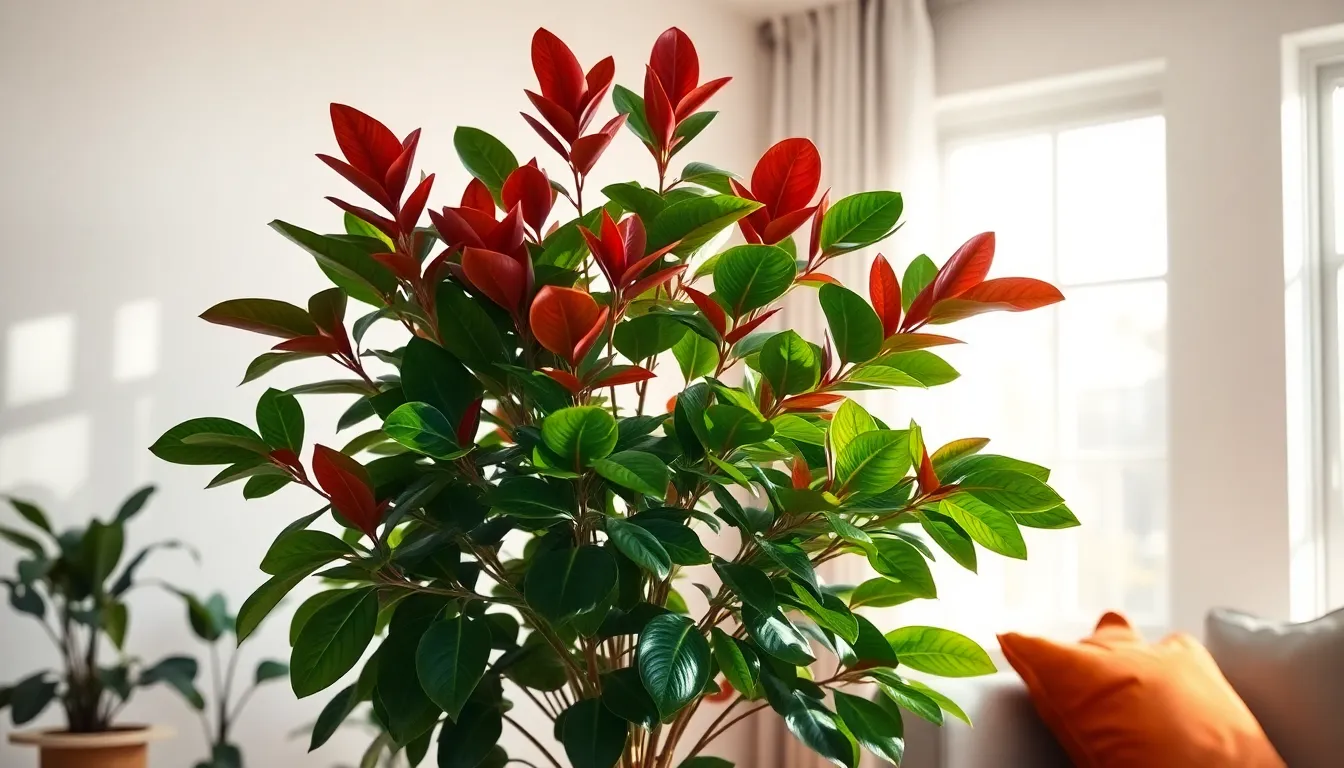
When we’re looking for a plant that makes a bold visual impact while remaining incredibly beginner friendly, the Rubber Tree (Ficus elastica) stands out as our top recommendation. This stunning houseplant combines dramatic aesthetics with the forgiving nature that new plant parents need to build confidence.
Large Glossy Leaves
Broad shiny leaves create an instant focal point in any room, transforming ordinary spaces into lush indoor sanctuaries. The Rubber Tree’s impressive foliage features thick, waxy surfaces that reflect light beautifully, adding depth and visual interest to your home decor. Each leaf can grow quite large, creating that coveted tropical atmosphere we all crave indoors.
Dramatic vertical presence makes this plant perfect for filling empty corners or serving as a living sculpture in your space. We love how the Rubber Tree’s substantial leaves provide that “wow factor” without requiring any special care techniques or complicated maintenance routines.
Forgiving Watering Schedule
Tolerance for occasional neglect makes the Rubber Tree ideal for beginners who might forget watering schedules or struggle with consistency. This resilient plant actually prefers its soil to dry out somewhat between watering sessions, which means we don’t have to worry about perfect timing.
Flexible watering needs accommodate busy lifestyles and learning curves that come with new plant ownership. Whether we accidentally underwater or occasionally skip a week, the Rubber Tree’s forgiving nature helps prevent the common mistakes that often discourage beginners from continuing their plant journey.
Natural Air Filtration
Toxin filtering capabilities contribute to healthier indoor environments while we enjoy the plant’s aesthetic benefits. The Rubber Tree actively removes harmful pollutants from our air, creating cleaner breathing spaces throughout our homes.
Improved air quality happens naturally as the plant processes toxins through its large leaf surface area. We’re essentially getting a beautiful living air purifier that requires minimal effort while providing maximum visual and health benefits for our indoor spaces.
Peace Lily: The Flowering Indoor Favorite
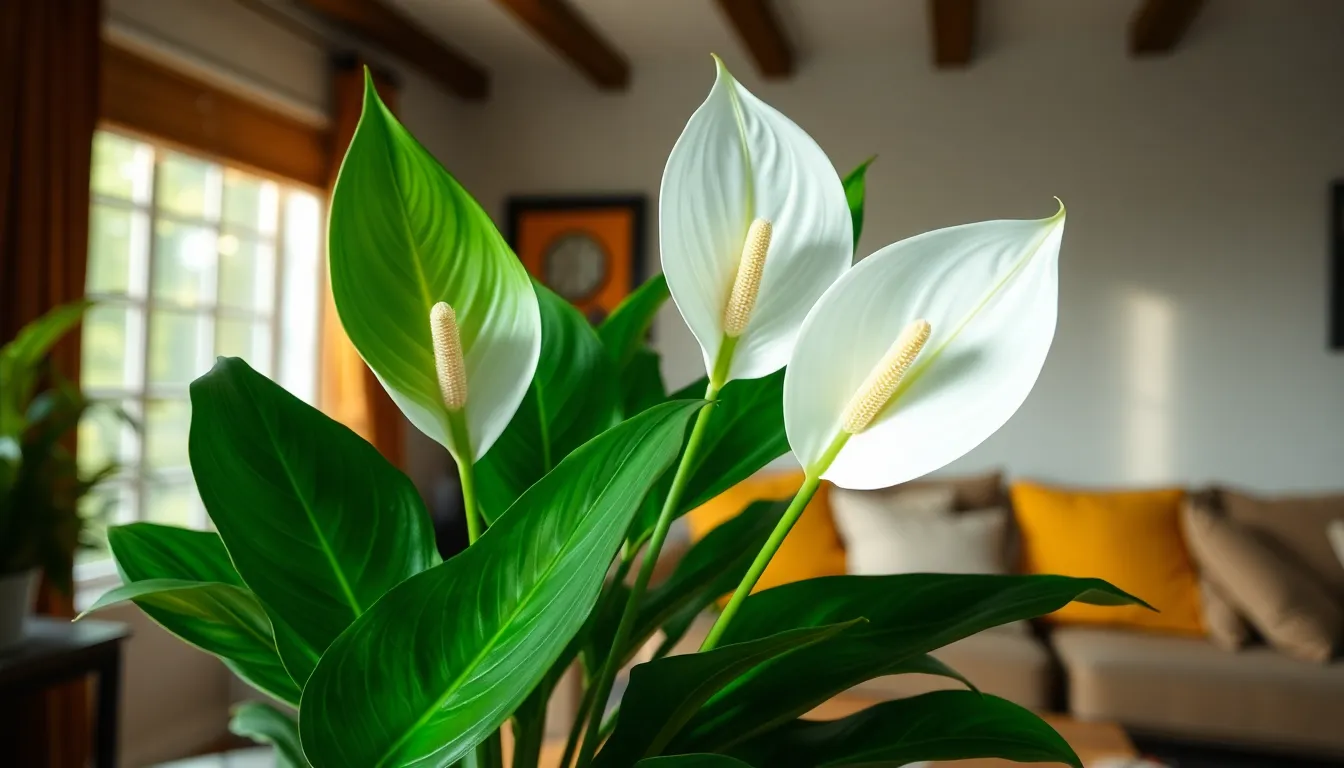
Peace Lilies offer something truly special that sets them apart from other beginner plants: gorgeous white flowers that bring elegance to any indoor space.
Beautiful White Blooms
Peace Lilies produce stunning white spathes that aren’t technically flowers but modified leaves called bracts. These creamy white blooms create a striking contrast against the plant’s deep green foliage, instantly elevating the aesthetic appeal of your home. We love how these elegant white flowers can brighten even the darkest corners of a room, making Peace Lilies perfect for adding sophistication to living rooms, bedrooms, or offices.
Unlike many houseplants that only offer foliage, Peace Lilies reward you with their signature white blooms throughout the year when properly cared for. Each bloom can last for several weeks, giving you extended periods of floral beauty without the expense of cut flowers.
Clear Watering Signals
Peace Lilies eliminate the guesswork from watering by giving you obvious visual cues when they need moisture. The plant’s leaves will visibly droop and become less perky when it’s time to water, making it nearly impossible to miss their hydration needs. We appreciate this built in communication system because it takes the anxiety out of plant care for beginners who worry about overwatering or underwatering.
Once you water a thirsty Peace Lily, you’ll see the leaves perk up within hours, providing immediate satisfaction and confirmation that you’ve done the right thing. This responsive behavior makes Peace Lilies excellent teaching plants for those learning to read their plants’ needs.
Moderate Light Preferences
Peace Lilies thrive in moderate, indirect light conditions that are common in most homes, making them incredibly adaptable to various indoor environments. They prefer bright, filtered light but can tolerate lower light levels better than many flowering plants, which makes them suitable for rooms that don’t receive abundant natural light. We find that Peace Lilies perform well when placed a few feet away from windows or in rooms with consistent ambient lighting.
Direct sunlight can actually harm Peace Lilies by scorching their leaves, so you don’t need to worry about finding the brightest spot in your home. This flexibility in lighting requirements means you can enjoy their beautiful blooms in bedrooms, bathrooms, or office spaces that might not be suitable for sun loving plants.
Aloe Vera: The Practical Succulent Choice
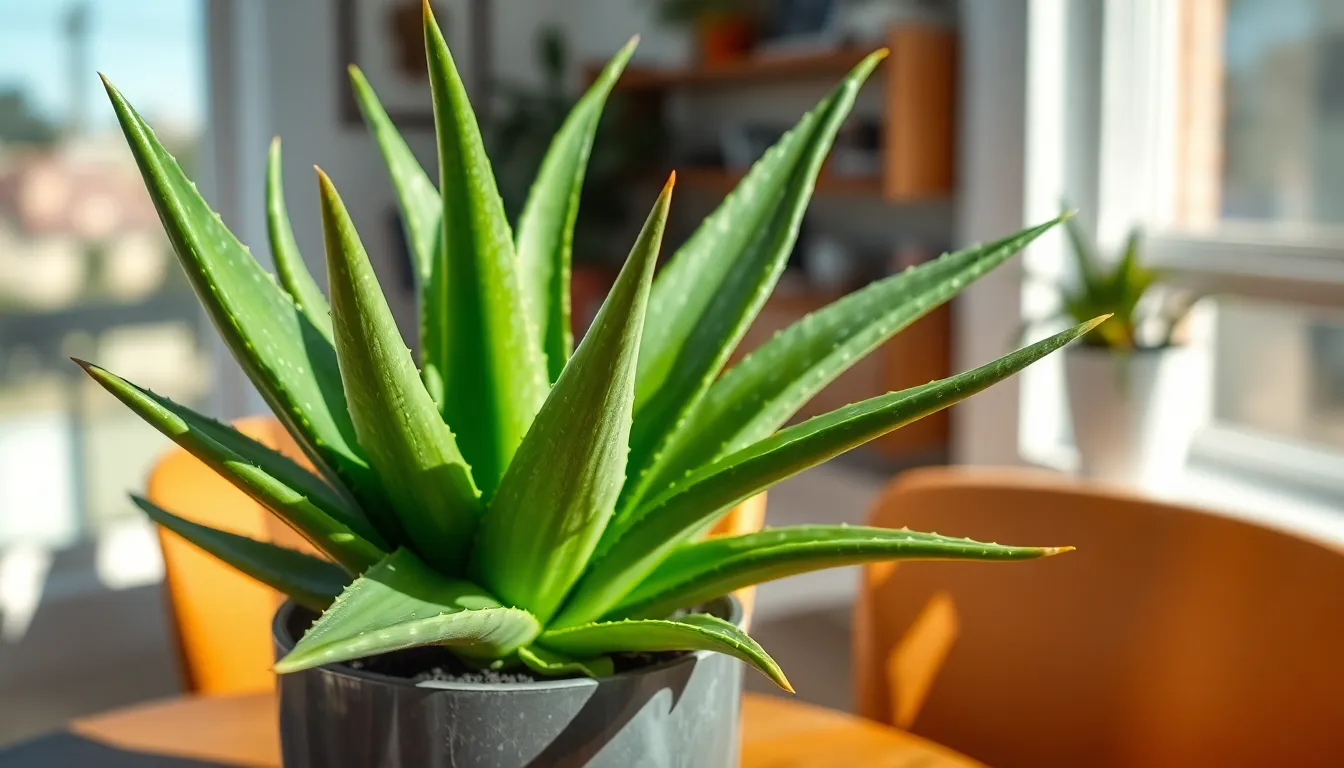
Among the most versatile beginner plants, aloe vera combines beauty with practicality. This succulent offers unique benefits that extend far beyond typical houseplant care.
Medicinal Properties and Uses
Aloe vera transforms your indoor garden into a natural medicine cabinet. The gel inside its thick leaves contains compounds with antibacterial and anti-inflammatory effects, making it invaluable for treating minor burns and skin irritations. We’ve found that having fresh aloe gel readily available proves especially helpful for kitchen burns and sunburn relief.
Breaking open a leaf releases the clear, soothing gel that has been trusted for centuries. Simply cut a small section from a mature leaf and apply the gel directly to affected skin. This immediate access to natural healing makes aloe vera one of the most practical plants you can grow indoors.
Minimal Water Requirements
Aloe vera thrives on neglect, storing water in its succulent leaves for extended periods. This drought-resistant plant requires watering only every 2-3 weeks during growing season and even less frequently in winter. We recommend allowing the soil to dry completely between waterings to prevent root rot.
Overwatering poses the biggest threat to aloe vera health, making it perfect for beginners who worry about plant care schedules. Its ability to survive weeks without water means you can travel or forget to water without harming your plant. This resilience makes aloe vera an ideal choice for busy individuals or those new to plant care.
Offset Production for New Plants
Aloe vera naturally produces offspring called “pups” or offsets around its base, creating new plants without any effort on your part. These baby plants develop their own root systems while still attached to the mother plant. We’ve observed that mature aloe vera plants can produce multiple offsets throughout the growing season.
Separating these pups is remarkably simple and requires only a clean knife to cut between the mother plant and offset. Each separated pup can be planted in its own pot with well-draining soil, instantly expanding your plant collection. This natural propagation method allows you to share plants with friends or create a larger aloe vera display without purchasing additional plants.
Monstera Deliciosa: The Instagram-Worthy Beginner Plant
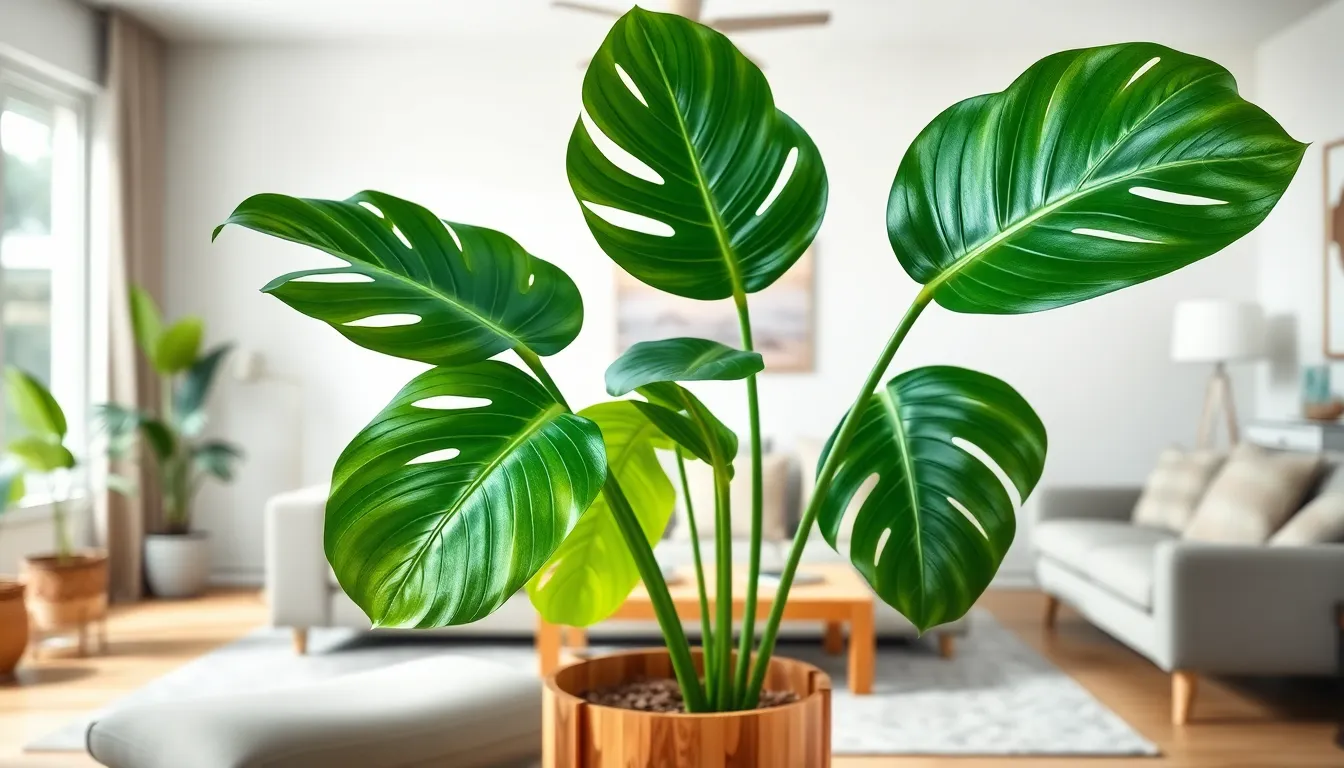
We’ve discovered that Monstera Deliciosa stands out as one of the most photogenic plants for beginners who want to make a stylish statement. This tropical beauty combines dramatic visual appeal with surprisingly manageable care requirements.
Distinctive Split Leaves
Distinctive Split Leaves make Monstera the star of any indoor plant collection. These iconic fenestrations develop as the plant matures, creating increasingly dramatic patterns that transform your space into a tropical oasis. Young plants start with solid heart-shaped leaves, but as they grow, natural splits and holes appear, giving each leaf its unique character.
Social media enthusiasts particularly love these striking leaves because they photograph beautifully in natural light. The glossy surface reflects light perfectly, creating depth and visual interest that makes every photo Instagram-worthy. Each mature leaf can span up to 2 feet across, making a bold statement piece in any room.
Climbing Growth Habit
Climbing growth habits allow Monstera to maximize vertical space while creating living art on your walls. In its natural habitat, this plant climbs trees using aerial roots, and we can replicate this behavior indoors with moss poles or trellises. Supporting structures encourage larger leaf development and more pronounced fenestrations.
Without support, Monstera will trail gracefully, making it perfect for plant stands or elevated planters. The aerial roots that emerge from nodes can be tucked into soil or wrapped around supports to encourage upward growth. This versatility means you can train your plant to fit your space perfectly, whether you prefer a compact tabletop display or a dramatic floor-to-ceiling statement.
Moderate Care Requirements
Moderate Care Requirements make Monstera surprisingly forgiving for beginners even though its exotic appearance. We recommend placing it in bright, indirect light where it’ll thrive without the risk of leaf burn from harsh direct sunlight. East or north-facing windows provide ideal conditions for healthy growth.
Watering becomes simple once you establish a routine of checking the top inch of soil. When it feels dry, it’s time to water thoroughly until water drains from the bottom. This typically happens every 1-2 weeks, depending on your home’s humidity and temperature.
Temperature consistency matters more than perfection, with ideal ranges between 65-85°F that match most indoor environments. Monthly feeding during spring and summer with balanced liquid fertilizer supports healthy growth without overcomplicating your plant care routine. The plant’s tolerance for occasional neglect means you won’t stress about perfect care while still enjoying dramatic results.
Philodendron: The Heart-Shaped Leaf Classic
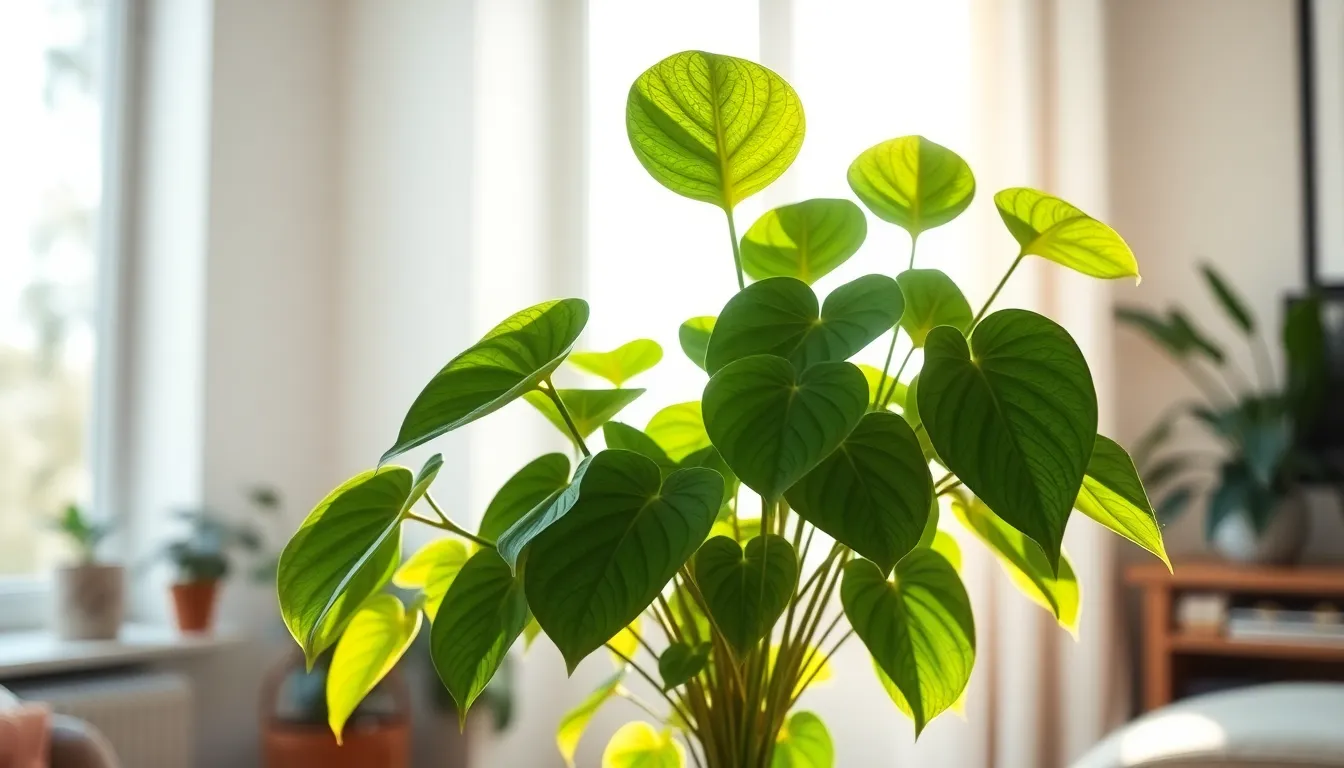
Philodendrons bring timeless elegance to our indoor gardens with their distinctive foliage and remarkable beginner-friendly nature. These versatile plants consistently rank among the most popular houseplants for new plant parents seeking both beauty and reliability.
Heart-Shaped Foliage Appeal
Heart-shaped leaves create the philodendron’s signature charm that instantly transforms any indoor space into a lush sanctuary. Classic green foliage adds visual warmth to rooms while maintaining an elegant aesthetic that complements virtually any decor style. We love how these iconic leaves create natural focal points that brighten corners and empty spaces without overwhelming smaller rooms. Each leaf develops its characteristic heart shape as it matures, creating an ever-changing display of natural beauty throughout the growing season.
Low Light Adaptability
Low light conditions don’t phase philodendrons, making them perfect for offices, bathrooms, and north-facing windows where other plants might struggle. These resilient plants thrive in medium to bright indirect light but gracefully tolerate dimmer environments without losing their vibrant appearance. We’ve found that philodendrons maintain healthy growth even in spaces with limited natural light, though faster development occurs in brighter conditions. Their adaptability to various lighting situations means we can confidently place them throughout our homes without worrying about exact light requirements.
Easy Maintenance Routine
Easy care requirements make philodendrons ideal for beginners who want stunning results without complex maintenance schedules. We recommend watering when the top inch of soil feels dry, typically every 7-10 days depending on your home’s humidity levels. During spring through fall growing seasons, monthly applications of water-soluble houseplant fertilizer support healthy development and vibrant foliage. These forgiving plants rarely need repotting and tolerate occasional neglect, making them perfect for busy lifestyles where consistent plant care might be challenging.
Essential Care Tips for Indoor Plant Success
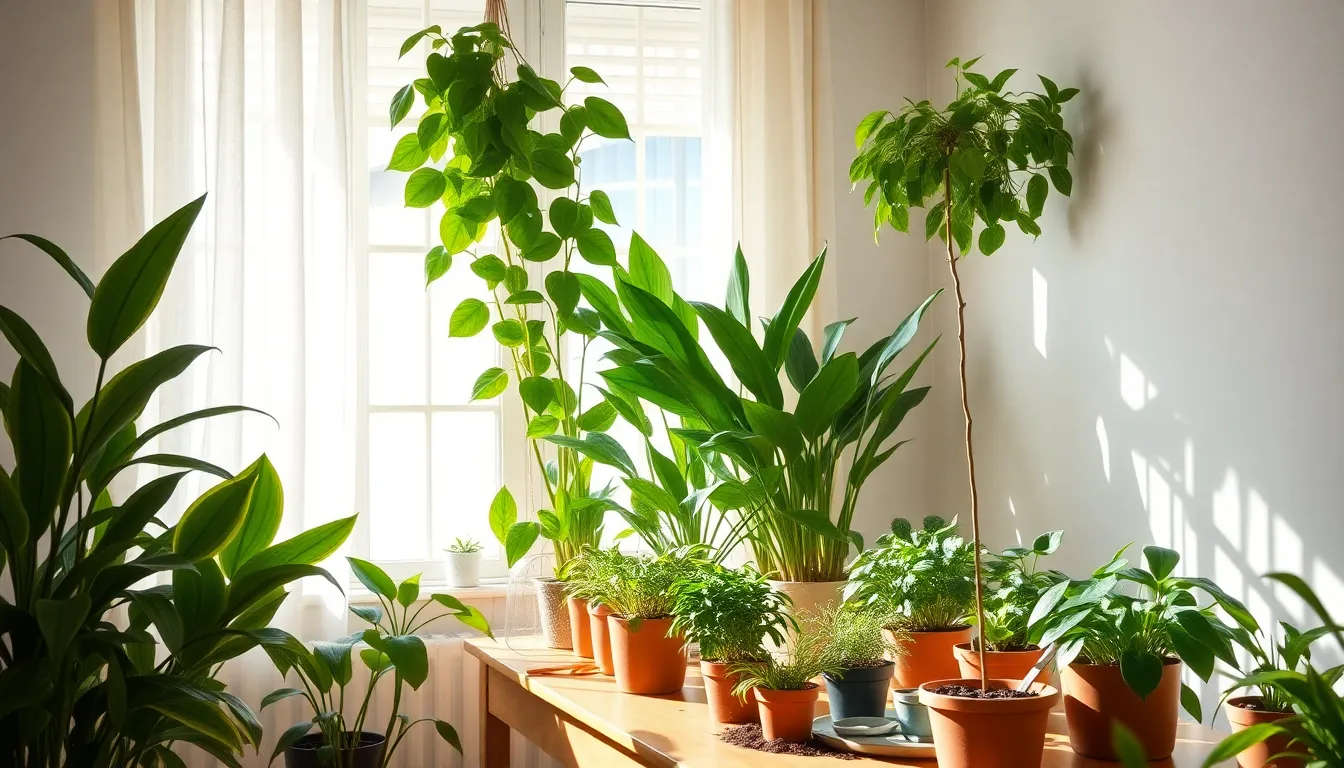
Now that we’ve explored the best beginner plants, let’s master the fundamental care techniques that’ll keep your green companions thriving.
Proper Watering Techniques
Understanding your plant’s natural habitat is crucial for proper watering. Succulents like Snake Plants and Fishbone Cactus need infrequent but deep watering, while tropical varieties like Pothos require more consistent moisture to stay healthy.
Overwatering kills more houseplants than underwatering. We recommend ensuring all pots have drainage holes to prevent water from sitting at the bottom. If your decorative pot lacks drainage, place drainage materials like rocks or pebbles under the soil to create air pockets.
Timing matters more than strict schedules when watering indoor plants. Check the soil moisture by inserting your finger about an inch deep into the potting mix. Most beginner plants need water when the top inch feels dry to the touch.
Quality potting soil makes watering more effective. Use soil appropriate for your exact plant type, and remember to repot every 1-2 years with fresh potting mix. During growing seasons (spring and summer), supplement with balanced fertilizer to support healthy growth.
Light Requirements and Placement
Matching plants with their light preferences ensures long-term success. Low-light tolerant varieties like ZZ Plants and Snake Plants thrive in shaded indoor areas, while sun-loving plants like Yucca require bright direct sunlight near south-facing windows.
Gradual light transitions prevent plant shock and leaf damage. Avoid placing plants in direct, harsh sunlight abruptly, as this can cause sunburn on delicate leaves. Instead, acclimate them slowly over several days when moving to brighter locations.
Stability in placement allows plants to establish their rhythm. Keep your plants in one location for 3-4 weeks minimum to let them adjust and develop their growth patterns. Frequent moves stress plants and slow their development.
Bright indirect light works best for most beginner-friendly houseplants. Position plants near windows but away from direct sun rays, or use sheer curtains to filter intense sunlight while maintaining adequate brightness.
Common Beginner Mistakes to Avoid
Watering mistakes top the list of plant care errors. Both overwatering and underwatering stem from misunderstanding individual plant needs rather than following generic advice. Research your exact plants’ requirements instead of applying one-size-fits-all approaches.
Moving plants frequently prevents proper acclimatization. Plants need time to adjust to their environment, and constant relocation stresses them unnecessarily. Choose suitable spots and let your plants settle in.
Using inappropriate soil types limits plant growth potential. Regular garden soil doesn’t work for indoor containers, and different plants need specialized potting mixes. Succulents require well-draining soil, while tropical plants prefer moisture-retaining blends.
Sudden sun exposure causes irreversible leaf burn. Gradually introduce plants to brighter conditions over several days to prevent scorched, brown patches on foliage that won’t recover.
Ignoring drainage needs leads to root rot disasters. Poor drainage creates waterlogged conditions that suffocate roots and promote fungal growth. Always ensure excess water can escape from containers.
Conclusion
Starting your indoor plant journey doesn’t have to be intimidating. With these carefully selected beginner-friendly plants we’ve shared you’re equipped to create a thriving indoor garden that fits your lifestyle and experience level.
Remember that every plant parent starts somewhere and these resilient varieties are designed to grow alongside your developing green thumb skills. From the nearly indestructible snake plant to the gorgeous Monstera Deliciosa each option we’ve covered offers unique benefits while remaining forgiving of occasional mistakes.
Your indoor space is about to transform into a healthier more vibrant environment. Take that first step pick one or two plants that speak to you and watch as your confidence and collection naturally expand over time.
Frequently Asked Questions
What are the best indoor plants for complete beginners?
The best beginner-friendly indoor plants include snake plants, pothos, spider plants, ZZ plants, rubber trees, peace lilies, aloe vera, monstera deliciosa, and philodendrons. These plants are chosen for their resilience, low maintenance requirements, and ability to forgive occasional neglect, making them perfect for those new to indoor gardening.
How often should I water my indoor plants?
Watering frequency depends on the specific plant type and environmental conditions. Most beginner-friendly plants like snake plants need watering every 2-3 weeks, while others like peace lilies provide visual cues by drooping when thirsty. Always check the top inch of soil – if it’s dry, it’s time to water.
Can indoor plants really purify the air in my home?
Yes, many indoor plants are natural air purifiers. Snake plants, rubber trees, and peace lilies effectively remove harmful toxins from indoor environments. Snake plants even produce oxygen at night, making them excellent bedroom companions. These plants provide both aesthetic appeal and health benefits with minimal effort.
Which indoor plants are safe for pets?
Spider plants are completely non-toxic to pets, making them an excellent choice for households with cats or dogs. However, many popular houseplants can be harmful to pets if ingested. Always research plant toxicity before bringing new plants home, and consider placing plants in elevated locations if pets show interest.
How do I propagate indoor plants to grow my collection?
Many beginner plants offer easy propagation methods. Pothos can be propagated in water or soil from cuttings. Snake plants can be divided or grown from leaf cuttings. Spider plants naturally produce “babies” that can be rooted easily. Aloe vera produces offsets or “pups” that can be separated and replanted.
What’s the most common mistake new plant parents make?
Overwatering is the most frequent mistake beginners make. Many plants prefer to dry out between waterings, and constantly wet soil can lead to root rot. Other common mistakes include frequently moving plants, using inappropriate soil types, and suddenly exposing plants to bright sunlight without gradual acclimation.
Do indoor plants need special soil or fertilizer?
Most indoor plants thrive in well-draining potting soil rather than garden soil. Ensure pots have drainage holes to prevent waterlogging. During growing season, light fertilizing can help, but many beginner plants are quite forgiving and don’t require frequent feeding. Focus on proper watering and lighting first.
How much light do indoor plants actually need?
Light requirements vary by plant type. Snake plants and pothos adapt to various lighting conditions, from low to bright indirect light. ZZ plants tolerate low light extremely well, while rubber trees and monstera prefer bright, indirect light. Avoid placing most houseplants in direct sunlight, which can scorch leaves.



